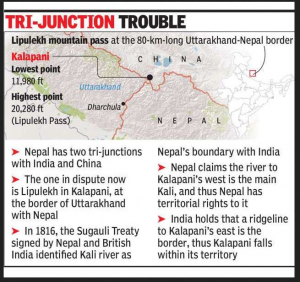

Delhi has begun a long-overdue outreach to Nepal with whom relations have been uneven in recent months.
Context
- Delhi has begun a long-overdue outreach to Nepal with whom relations have been uneven in recent months.
About:
- Prime Minister Narendra Modi and his Nepal counterpart Khadga Prasad Sharma Oli spoke with each other in a prelude to meeting between officials of both sides to discuss the territorial spat over the Lipulekh-Limpiyadhura-Kalapani trijunction.
- India and Nepal agreed to speed up work on bilateral projects, including infrastructure schemes and cross-border rail links, as senior officials of the two sides held a meeting for the first time since a border row strained ties.
- In that connection, they agreed to undertake necessary measures to timely address problems and obstacles in the course of implementation.
- This was the eighth meeting of the mechanism, set up in 2016 to monitor the progress of India-funded projects, and it carried out a comprehensive review of economic and development cooperation schemes since the last meeting in July 2019.
What went wrong in relation?
- Madhesi Issue: Nepal promulgated its new Constitution in 2015 but the Madheshis, the Janajatis and the Tharus, who is considered as the marginalized groups felt they were being left out in the new constitution. These groups, Madheshi in particular, then blocked the border points. The Nepalese government accused India of deliberately worsening the embargo by not allowing vehicles to pass from check-points where no protests were held. Indian government however denied all allegations of any involvement in the blockade.
- Political map issue:2019 After the abrogation of Article 370 in Jammu and Kashmir, India released its updated political map in which Kalapani, close to Lipulekh pass was shown in Indian Territory as it always was, suddenly Nepal protested officially and stated it’s a disputed territory and New Delhi has no right to include the area in India.
- 2020 May 8, India’s defence minister virtually inaugurated a new 80 km-long road in the Himalayas, connecting to the border with China, at the Lipulekh pass. The Nepali government protested immediately, contending that the road crosses territory that it claims and accusing India of changing the status quo without diplomatic consultations.

- June 13th and 14th, 2020 The Lower House of Nepal’s Parliament unanimously passed the historic Second Constitution Amendment Bill guaranteeing legal status for the updated political map of Nepal which includes Limpiyadhura, Kalapani and strategically important Lipulekh Pass which were India’s territories in Uttarakhand’s Pithoragarh district.
Growing Chinese Influence in Nepal: Threats and Challenges
- While India has its roots in Nepal through cultural ties and soft power, China has been ambitiously establishing relations with the landlocked nation through economic diplomacy.
- It is felt in India that the Chinese inroads into Nepal are necessarily to counterbalance the Indian influence in Nepal. However, Nepal has asserted that its relationship with China is purely economic and will not be hurting the Indian strategic interests in any way.
- Further, it is believed by India that the rising Nepal and China cooperation would undermine Nepal’s distinction of buffer state between India and China.
- As a result of the economic blockade between India and Nepal in 2015, the latter turned to China to seek help in meeting its energy demands. Quick to grab the opportunity, China provided 33 per cent of the country’s fuel requirements, also allowing Nepal to use four of its seaports and three land ports.
- In recent times, to cope up with the Chinese dominance in the region, South Asia’s first ever transnational oil pipeline was launched from India’s Motihari district in Bihar to Amlekhgunj in Nepal.
- Beijing has lured Nepal’s private schools to offer Mandarin as a language in exchange for the Chinese covering the salaries of teachers in those schools. This coincides with China’s ambitious Belt and Road Initiative in Nepal.
- China is successfully delivering several infrastructure projects in Nepal. It is building a new airport in Pokhara to encourage tourism, a Himalayan railway line that plans to connect Kathmandu to Lhasa, hydroelectric projects, to name a few.
- The Kathmandu-Lhasa railway line will establish a solid physical connectivity too, allowing Kathmandu to be flooded with Chinese goods, destroying medium and small scale industries- both in Nepal and India.
- India’s ability to complete infrastructure projects on time has remained dismal. The Chinese on the other hand are exceptional with their engineering marvel.
- The importance of hydroelectric projects in Nepal is humongous. China has been assisting Nepal in that field too, by allowing them to generate more hydropower than before.
Way forward:
- India and Nepal have had the most progressive relations in South Asia, with open borders and a free intermingling of people, almost European in vision and scope. The sooner India settles this dispute with Nepal, the lesser the chances for China to get involved.
- India-Nepal border issues appear more easily solvable, so long as there is political goodwill and statecraft exercised on both sides. The way to move forward is to formally approve the strip maps, resolve the two remaining disputes, demarcate the entire India-Nepal boundary, and speedily execute the work of boundary maintenance.
- There is an immediate need to deescalate and compartmentalise. The first requires verbal restraint on the part of Prime Minister Oli and India’s willingness to talk even as the pandemic continues.
Conclusion:
Based on their history of friendly relations and driven by pragmatism, it should not be difficult for India and Nepal to think out of the box and find a practical solution. Delhi and Kathmandu could lead the way to liberate the subcontinent from the sovereignist, nationalist and territorial logic that continues to leave everyone in the region worse off.

